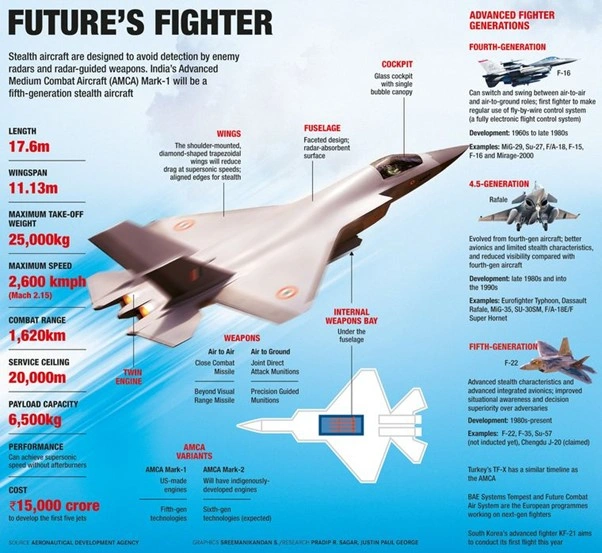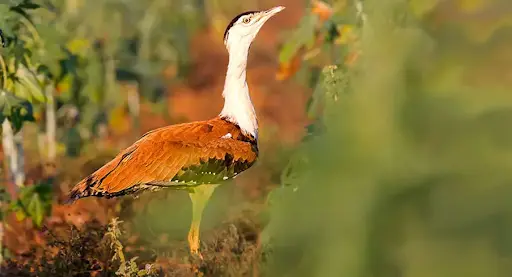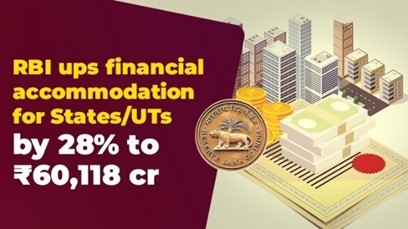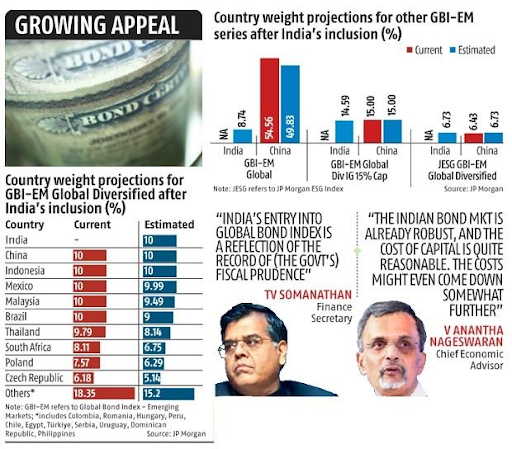Thursday, 4th July 2024
India-France Partnership in Green Growth
Why in the news ?
- Recently, the President of France and the Prime Minister of India elevated the 'Partnership for the Planet' as one of the three pillars of the Indo-French Horizon 2047 Roadmap in 2023.

Background:
- 25 Years of India-France Strategic Partnership: Celebrated in 2023.
- Pillars of Indo-French Horizon 2047:
- Partnership for security and sovereignty
- Partnership for the planet
- Partnership for the people
- Partnership for Environment Sustainability
Environment Protection Projects:
- Rajasthan Forest Cover Project: Aims to increase forest cover in Rajasthan, supporting wildlife habitat and local livelihoods.
- Sanitation Improvement in Himachal Pradesh: Targets enhancing sanitation facilities in small towns of Himachal Pradesh.
- Solid Waste Management under CITIIS: Focuses on improving solid waste management in 18 cities through CITIIS, India’s circular economy initiative.
- Green Credit Line for Electric Buses: Disbursed by the State Bank of India to promote the adoption of electric buses.
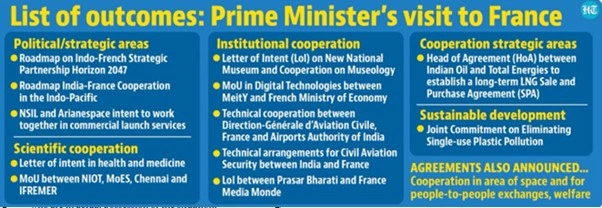
What are the Major Areas of Cooperation between India and France?
● Strategic Partnership:
- 1998 Nuclear Tests: After India’s 1998 nuclear tests, France initiated the first Strategic Dialogue with India.
- Understanding Security Compulsions: France showed understanding by refraining from imposing bilateral sanctions on India.
- First Western Strategic Partnership: India signed its first strategic partnership with France among western countries.
● Economic Relations:
- Trade Growth: Bilateral trade reached $13.4 billion in 2022-23.
- FDI: France is a major investor in India, with FDI inflow reaching $659.77 million for FY 2022-23.
- Trade Stats for FY 2023-24: Indian exports to France totaled $3.06 billion, while imports from France totaled $2.36 billion.
● Defence Cooperation:
- Bilateral Mechanisms: Annual Defence Dialogue (Defence Minister level) and High Committee on Defence Cooperation (Secretary level).
- P-75 Scorpene Deal (2005): Agreement for building six Scorpène submarines with French technology transfer at Mazagaon Docks Ltd., India.
- Rafale Jets Procurement: India’s acquisition of Rafale jets underscores deep defence ties.
- Joint Exercises: Regular joint exercises between Air Forces (Garuda series), Armies (Shakti), and Navies (Varuna).
● Space Cooperation:
- Long-standing Collaboration: Over 50 years of collaboration between ISRO and the French Space Agency (CNES).
- Supply of Components: France remains a major supplier of components and equipment for India’s space programme.
● Energy Cooperation
- Jaitapur Nuclear Power Project (JNPP): Progress has been slow since the agreement in 2008.
- Small Modular Reactors (SMR) and Advanced Modular Reactors (AMR): Partnership agreed upon.
- International Solar Alliance: Joint initiative launched by India and France.
● Education and Community
- Indian Students in France: Around 10,000 Indian students; agreement to increase to 30,000 by 2030.
- Indian Community in France: Approximately 119,000 members, originating from former French colonies and Indian states.
● Tourism
- Tourism Numbers: 2.5 lakh French visitors to India in 2019; 7 lakh Indian tourists visited France.
- Preferred Destination: Rajasthan is the leading destination in India for French tourists.
● Support on International Fora:
- UNSC Membership: France supports India’s claim for permanent membership in the UN Security Council.
- International Agreements: France supported India’s accession to MTCR, WA, and AG; supported India’s NSG bid.
- CCIT Adoption: Joint effort for adoption of the Comprehensive Convention on International Terrorism (CCIT) at the UN.
What are the Challenges Between India-France Relations?
● FTA and BTIA Stagnation:
- Free Trade Agreement (FTA) Absence: The lack of an FTA between France and India limits their trade potential.
- India-EU BTIA Slow Progress: Slow advancement in the India-EU Broad-Based Trade and Investment Agreement (BTIA) complicates efforts for comprehensive economic cooperation.
● Differing Defense and Security Priorities:
- Diverse Strategic Approaches: Despite strong defence ties, divergent regional and global priorities between India's "non-aligned" policy and France's global interests can influence defence and security cooperation.
● Intellectual Property Rights Concerns:
- IPR Protection Issues: France has expressed concerns about India's insufficient protection of intellectual property rights, impacting French businesses operating in India and posing challenges to bilateral trade facilitation.
● Trade Imbalance and Defense Dominance:
- Trade Disparity: Despite being India's 11th trade partner, there exists a noticeable trade imbalance.
- Defence Product Dominance: Over-reliance on defence products in trade relations hinders diversification and balanced economic exchange.
● Barriers to Indian Products in France:
- SPS Measures: India faces challenges exporting products to France, particularly due to Sanitary and Phytosanitary (SPS) measures, posing barriers to market access for Indian goods.
● Student Mobility Issues:
- Challenges in Student Exchange: Plans to host 30,000 Indian students in France face hurdles related to visa processes and cultural integration, potentially hindering the realisation of this objective.
● Human Trafficking Concerns:
- Transnational Crime Challenges: Incidents like the Nicaragua flight case highlight concerns over human trafficking, emphasising the need for enhanced bilateral cooperation in combating transnational crimes and ensuring individual safety and welfare.
Way Forward:
- India and France can collaborate to influence and balance the international order, leveraging their mutual strengths and reducing dependency on other nations.
- The Indo-Pacific framework enhances Franco-Indian relations, with France’s strategic interests in the Indian Ocean supporting stability.
- France’s support is crucial for India’s efforts to enhance domestic weapon production through increased private and foreign investment.
- Discussions should broaden to include emerging areas such as connectivity, climate change, cyber-security, and science and technology.
|
UPSC Civil Services Examination, Previous Year Questions (PYQs) Prelims: Q:1 Consider the following statements: (2016)
Which of the statements given above is/are correct? (a) 1 only (b) 2 only (c) Both 1 and 2 (d) Neither 1 nor 2 Ans: (a) Mains: Q:1 How will the I2U2 (India, Israel, UAE and USA) grouping transform India's position in global politics? (2022) |
Source: TH
Great expectations, liberalism in dark times
Why in the news ?
- Democratic forces hold a resilient hope, capable of countering and uprooting divisive political aberrations when the moment is right.
About the Liberalism:
- Liberalism is a political and philosophical ideology that prioritises individual rights, liberty, equality under the law, and limited government intervention in personal and economic matters.
- It advocates for fundamental freedoms such as freedom of speech, press, religion, and assembly, and supports democratic processes, the rule of law, and the protection of civil liberties.
- Liberalism also aims for social progress through tolerance, pluralism, and a commitment to human rights and justice.
Electoral outcomes:
- Public Opinion Shift: Recent elections in Europe and India reveal a notable turn towards conservative and right-wing ideologies, underscored by climate scepticism, anti-immigration sentiments, and nationalism.
- Voter Response: Contrary to expectations, Indian voters showed a strong rejection of perceived authoritarianism and communalism, reaffirming their commitment to democratic values and rights.
- Minority Reassurance: The election outcomes provided reassurance to minority communities, especially Muslims, addressing concerns of marginalisation and insecurity amid exclusionary policies and communal tensions.
- Strengthened Democracy: The results are viewed as a testament to democracy's resilience, fostering checks and balances against oppressive regimes and divisive politics.
- Optimism for Opposition: There is optimism about a robust opposition emerging to hold the government accountable, stimulate debate, and protect diverse civil society interests.
- Challenges Ahead: Voters expect governance that addresses issues like poverty, unemployment, and hunger with rationality, justice, and responsiveness.
- Ethical Governance: Emphasis is on ethical governance that universally respects human rights, ensuring no discrimination based on ethnicity, religion, or political affiliation
Verdict and the Advent of Hope:
- Democratic Challenges: There is a global concern over the decline of democratic values, with accusations against right-wing governments for manipulating truth and using oppressive tactics to maintain power.
- Advocating Moderate Liberalism: There is a call for ruling administrations to embrace a tempered form of liberalism, rejecting practices that undermine democratic norms and freedoms.
- Role of the Opposition: Expectations are placed on opposition alliances to uphold principles of humility, pluralism, and modesty, serving as a counterbalance to dominant political forces.
- Reflective Thought: Election outcomes prompt reflection on political astuteness and statesmanship, crucial for steering democracy amidst contemporary global challenges.
- Spinoza's Insight: Drawing from Spinoza, the clash between natural self-interest and civil responsibility underscores the importance of societal order governed by law and morality to safeguard rights and prevent chaos.
- Hope and Scepticism: The Indian electoral outcome evokes a dual sentiment of hope and scepticism, influencing the future trajectory of democracy and fostering philosophical contemplation.
Challenges to liberalism:
- Rise of Right-Wing Ideologies: Globally, there is a surge in right-wing sentiment characterised by climate scepticism, anti-migration views, and nationalist fervour, challenging liberal values and policies.
- Threats of Authoritarianism and Communalism: The resurgence of authoritarianism and communal politics poses significant threats to democratic principles and societal harmony, particularly affecting marginalised communities such as Muslims.
- Mix of Hope and Despair: The electorate's response reflects a blend of hope and despair, with optimism focused on a resilient opposition and democratic institutions to protect fundamental rights and uphold diversity in civil society.
- Balancing Public and Private Realms: It is crucial to adopt a nuanced approach that reconciles private religious beliefs with public, politicised lifestyles while preserving individual rights and fostering a tolerant society.
Way Forward:
- Policy Reforms: Implement inclusive policies addressing economic, social, and regional disparities effectively, including targeted welfare programs to combat poverty, unemployment, and hunger.
- Social Integration: Promote initiatives that foster social cohesion and integration among diverse communities. Facilitate dialogue and understanding between different cultural and religious groups to reduce communal tensions.
- Democratic Checks and Balances: Strengthen the autonomy and efficacy of democratic institutions such as the judiciary, election commissions, and anti-corruption bodies. Ensure transparent and independent operations to uphold democratic values.
- Dialogue and Consensus-Building: Promote inclusive decision-making processes involving stakeholders from diverse backgrounds. Encourage constructive political dialogue and consensus-building on key policy issues.
|
UPSC Civil Services Examination Previous Year Question (PYQ) Mains: Q:1 In the context of the neo-liberal paradigm of development planning, multi-level planning is expected to make operations cost-effective and remove many implementation blockages.” Discuss. (2019) Q:2 'Whether the National Commission for Scheduled Castes (NCSC) can enforce the implementation of constitutional reservation for the Scheduled Castes in the religious minority institutions? Examine. (2018) |
Source: TH
Advanced Medium Combat Aircraft
Why in the news?
- The Defence Ministry is planning to involve the private sector significantly in the design and development of the indigenous fifth-generation fighter aircraft, the Advanced Medium Combat Aircraft (AMCA).
- This involvement is crucial for the timely execution of the project, with the first prototype expected by 2028-29, according to official sources.
About the Fifth-Generation Fighter Jets:
- Missions: Designed for air-to-air combat and ground attack.
- Features:
- Plain surfaces, specially shaped exhaust nozzles, and engines located in the plane's body to hide heat signatures.
- Special radars to detect the aircraft's own radar emissions.
- Global Examples: The F-22 Raptor and F-35A Lightning II (US), the J-20 Mighty Dragon (China), and the Sukhoi Su-57 (Russia).
Advanced Medium Combat Aircraft (AMCA):
● About the AMCA:
- Type: India’s fifth-generation multirole fighter jet.
- Size: Larger than other fighters in the Indian Air Force inventory.
- Significance: Positions India among a select group of nations with their own fifth-generation fighter aircraft.
● Organisations Involved:
- Design & Execution: Aeronautical Development Agency (ADA) under the Defence Research and Development Organisation (DRDO).
- Manufacturing: Hindustan Aeronautics Limited (HAL).
● Features:
- Stealth: Advanced stealth features to avoid detection by enemy radar.
- Fuel & Weapons: Large, concealed internal fuel tank (6.5-tonne capacity) and an internal weapons bay for a range of weapons, including indigenous ones.
- Engine:
- AMCA Mk1: Equipped with the US-built GE414 engine of the 90 kilonewton (kN) class.
- AMCA Mk2: More advanced variant with a 110kN engine, developed indigenously by DRDO’s Gas Turbine Research Establishment (GTRE) in collaboration with a foreign defence major.
Significance of Advanced Medium Combat Aircraft (AMCA)
● Indigenous Fifth-Generation Fighter Aircraft:
- Comparison: The AMCA will be India's indigenous fifth-generation fighter aircraft, compared to the 4.5-generation single-engine multirole Light Combat Aircraft (LCA) Tejas.
● Advanced Stealth Features:
- Stealth: Low electromagnetic signature, making it difficult for enemy radar to detect it.
- Sensors & Weapons: Powerful sensors and new weapons to register the signature of enemy aircraft and take them out.
● Higher Utilisation Time and Smaller Serviceability:
- Maintenance: Comprehensive Integrated Vehicle Health Management (IVHM) system to track multiple structural components and assess the condition of the aircraft in real-time.
● Addressing IAF’s Dwindling Numbers:
- Current Strength: The IAF has around 30 fighter squadrons against the sanctioned strength of 42.
- Future Needs: With the phasing out of MiG-21s, MiG-29s, Jaguars, and Mirage 2000s, the IAF needs seven squadrons of the AMCA to begin with.
● Strategic Significance:
- Regional Context: China’s development and deployment of the J-20 FGFA in Tibet bordering India.
● Clearance from Cabinet Committee on Security (CCS):
- Sanction: The AMCA project was sanctioned by the CCS in March 2024.
- Development Phases:
- Phase 1: Mk1 with the General Electric F414 engine.
- Phase 2: Mk2 with a more powerful engine, co-developed with Saran of France.
Source: TH
9 years of the Digital India initiative
Why in the news ?
- Recently, prime minister Narendra Modi has commended the successful completion of nine years of the Digital India initiative.
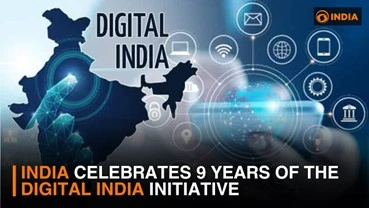
About Digital India Programme:
- Launch and Objectives:
- Launched on July 01, 2015, by Prime Minister Shri Narendra Modi, Digital India aims to transform India into a knowledge-based economy and a digitally empowered society.
- It focuses on ensuring digital services, access, inclusion, empowerment, and bridging the digital divide.
- Coordination:
- The programme is coordinated by the Ministry of Electronics and Information Technology (MeitY), with collaboration from Ministries and Departments of the Central and State Governments in their respective domains.
- Empowerment and Impact:
- Digital India symbolises an empowered India, enhancing Ease of Living and fostering transparency across various sectors.
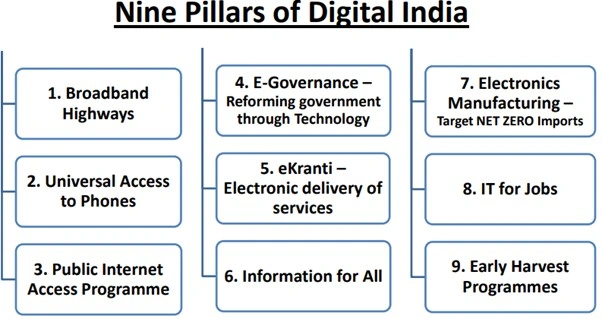
Achievements of Digital India Programme:
- Financial Inclusion
- Over 11 crore farmers now receive direct money transfers into their bank accounts, facilitated by the Digital India campaign.
- The AI chatbot launched with PM-Kisan in collaboration with the EKstep Foundation enhances financial assistance to farmers.
- Healthcare Access
- Ayushman Bharat leverages digital platforms to provide health insurance coverage, with over 34.6 crore Ayushman Cards issued.
- Digital Identity and Services
- DigiLocker has issued over 674 crore documents digitally, enhancing accessibility and reducing paperwork.
- Over 137 crore Aadhaar numbers have been generated, providing unique digital identity to Indians.
- Digital Infrastructure
- BharatNet has laid 6.83 lakh kilometres of optical fibre network, circling the Earth over 17 times, improving connectivity across rural India.
- Over nine crore FASTags issued, streamlining toll payments and digital vehicle management.
- Digital Literacy
- Pradhan Mantri Grameen Digital Saksharta Abhiyan (PMGDisha) empowers rural communities with digital skills, promoting participation in the digital economy.
- E-Governance and Transparency
- The Government e-Marketplace (GeM) offers 11,900 product categories and 321 service categories, enhancing transparency and efficiency in government procurement.
- Digital Payments
- BHIM, a UPI-based payment app, facilitates seamless digital transactions, with transactions exceeding 535 lakh crore rupees.
- Land Ownership
- Swamitva Scheme uses drones and technology to provide land titles to rural landowners, promoting transparency and reducing disputes.
- Financial Inclusion
- Jan Dhan Yojana has facilitated the opening of bank accounts for millions of unbanked individuals and promotes digital payments, reducing reliance on cash transactions.
Challenges:
- Digital Literacy: Ensuring widespread digital literacy remains a hurdle, particularly in remote areas where access to training and education is limited.
- Internet Penetration: Bridging the gap in internet penetration between urban and rural areas is crucial for equitable access to digital services.
- Cybersecurity: Protecting digital infrastructure and user data from cyber threats is a continuous challenge that requires robust measures and constant vigilance.
- Disparities in Access: Disparities persist in digital access, posing challenges in reaching marginalised communities and bridging the urban-rural divide effectively.
- Financial Resources: Adequate funding and resource allocation are essential to sustain and expand the initiative’s reach across diverse sectors and regions.
- Coordination: Given its broad scope covering multiple departments, effective coordination among stakeholders is necessary to ensure seamless implementation and maximise impact.
- Privacy Concerns: Balancing the convenience of digital services with robust privacy protection measures remains a critical issue, requiring careful policy considerations and technological solutions.
Conclusion:
Hence, the Digital India program has effectively transformed India into a digitally empowered society and knowledge-based economy, marking a significant milestone in the country's development trajectory. By fostering a culture of innovation and inclusivity, Digital India is set to pave the way for a more prosperous and connected nation..
|
UPSC Civil Services Examination Previous Year Question (PYQ) Prelims Q:1 Consider the following: (2022)
Which of the above are built on top of open-source digital platforms? (a) 1 and 2 only (b) 2, 3 and 4 only (c) 1, 3 and 4 only (d) 1, 2, 3 and 4 Ans: (d) Q:2 Which of the following is/are the aim/aims of the “Digital India” Plan of the Government of India? (2018)
Select the correct answer using the code given below: (a) 1 and 2 only (b) 3 only (c) 2 and 3 only (d) 1, 2 and 3 Ans: (b) Q:3 Regarding ‘DigiLocker’, sometimes seen in the news, which of the following statements is/are correct? (2016)
Select the correct answer using the code given below: (a) 1 only (b) 2 only (c) Both 1 and 2 (d) Neither 1 nor 2 Ans: (c)
Mains Q:1 “The emergence of the Fourth Industrial Revolution (Digital Revolution) has initiated e-Governance as an integral part of government”. Discuss. (2020) Q:2 How can the ‘Digital India’ programme help farmers to improve farm productivity and income? What steps has the Government taken in this regard? (2015) |
Source: :PIB
Li-Fi Technology
Why in the news ?
- Recently, the Ministry of Defence, under the Innovations for Defence Excellence (iDEX) initiative, granted the Li-Fi Technology to address the Indian Navy’s communication challenges.
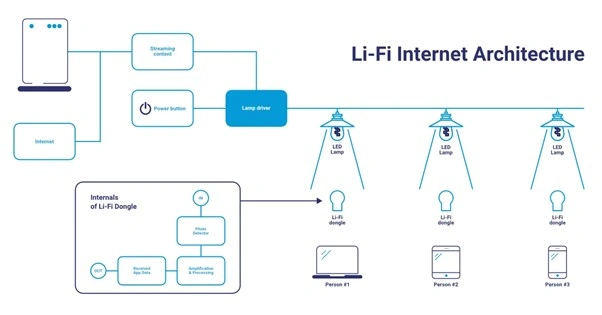 About the Li-Fi Technology:
About the Li-Fi Technology:
- Li-Fi is an advanced wireless communication technology that utilises visible light emitted by LEDs for data transmission.
- Unlike conventional Wi-Fi, which relies on radio waves, Li-Fi offers high-speed, secure, and energy-efficient communication channels.
Working Principles of Li-Fi:
- Data Transmitters: LiFi uses LED light modulation for binary data encoding, received and decoded by photodiodes for wireless data transmission via visible light communication.
- LED modulation: LiFi utilises LED bulbs that flicker to encode binary data through visible light communication (VLC).
- Transmitter encoding: A LiFi transmitter includes an LED driver that converts binary data into on-off light signals, adjusting data rates by varying the flicker rate.
- Receiver decoding: Photodiodes in a LiFi receiver detect changes in light intensity caused by obstructions and convert them back into the original data stream.
- Bidirectional communication: The transmitter near the photodiode modulates the LED light of the receiver to transmit data back, enabling bidirectional data flow.
- Operational light frequencies: LiFi operates within the visible light spectrum, typically between 430 to 770 THz, where photodiodes are highly sensitive. Infrared or ultraviolet frequencies can also be used.
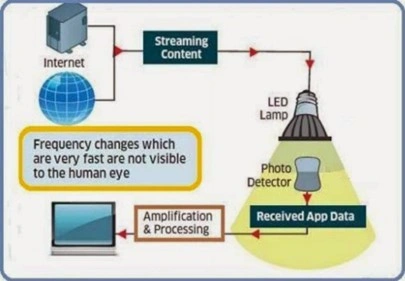
Advantages of Li-Fi:
- High Speed: LiFi can provide internet speeds over 100 Gbps, which is much faster than WiFi. This can enable high-speed applications.
- Security: Operating within the visible light spectrum, Li-Fi does not pass through walls, providing inherent security against eavesdropping.
- High density: The visible light spectrum has 10,000 times more bandwidth than radio waves, thus it does not have the problem of ‘spectrum crunch’, as with the radio waves.
- No Interference: LiFi uses visible light which does not cause electromagnetic interference. This allows its use in sensitive areas like aircraft and hospitals.
- Energy Efficiency: LEDs used in Li-Fi are energy-efficient, contributing to overall energy savings.
- Prevention of "dead zones": LED bulbs in LiFi eliminate dead zones by illuminating areas within buildings where radio waves from WiFi routers cannot reach.
Challenges and Considerations:
- Line of Sight: Effective transmission in Li-Fi requires a direct line of sight between the LED transmitter and the photodetector receiver.
- Indoor Use: Li-Fi is particularly suitable for indoor environments like offices, hospitals, and smart homes.
- Integration Challenges: Integrating Li-Fi with existing infrastructure and devices remains a significant challenge.
Applications of Li-Fi:
- Internet Connectivity and Indoor Communication: Li-Fi provides high-speed internet access in offices, homes, and public spaces.
- Secure Environments: Military bases, hospitals, and data centres benefit from Li-Fi’s enhanced security features.
- Underwater Communication: Li-Fi technology is also viable for underwater communication, where traditional RF signals are ineffective.
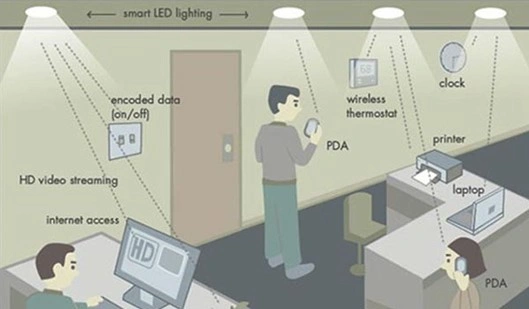
Way forward:
- Standards development: Establishing standards for components, networking protocols, and installation practices is crucial for ensuring interoperability across LiFi systems.
- Integration with networks: Improving integration with existing networks such as 5G and WiFi will enhance the complementary benefits of LiFi technologies.
- Cost reduction: Technological advancements and economies of scale should drive down costs to make LiFi more accessible and adopted widely.
- Policy support: Government policies should incentivize the development of LiFi infrastructure to promote its use in public services and beyond.
- Private sector collaboration: Collaborations among academia, industry, and startups are essential to foster innovation and commercialization of LiFi technology.
|
UPSC Civil Services Examination Previous Year Question (PYQ)
Q:1 With reference to ‘Li-Fi’, recently in the news, which of the following statements is/are correct? (2016)
Select the correct answer using the code given below. (a) 1 only (b) 2 only (c) Both 1 and 2 (d) Neither 1 nor 2 Answer: (c) |
Source: FE
India Won the 2024 T20 World Cup
Why in the news ?
- Recently, India secured their first ICC title since the 2013 Champions Trophy by winning the ICC T20 World Cup in Barbados, ending a drought in major ICC tournaments.
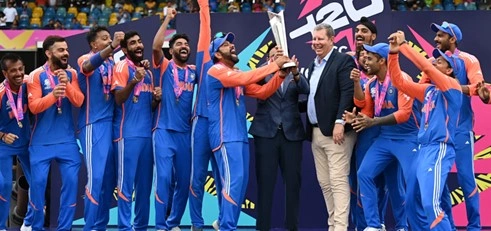
About the T20 World Cup:
- Inception: The T20 World Cup began in 2007 as an international cricket championship, held approximately every two years.
- Evolution: Started with 12 teams, expanded to 16 teams from 2014, and featured 20 teams across four groups in the 2024 edition.
Key India's Journey in WC:
- 2007: India won the inaugural men's Twenty20 World Cup in South Africa, defeating Pakistan in the final under MS Dhoni's captaincy.
- 2014: India finished as runners-up, losing to Sri Lanka in the final.
Teams with Multiple Wins:
- India: 2007 & 2024
- West Indies: 2012 & 2016
- England: 2010 & 2022
- Noteworthy: England became the first team to simultaneously hold both the men's ODI World Cup (2019) and the T20 World Cup (2022).
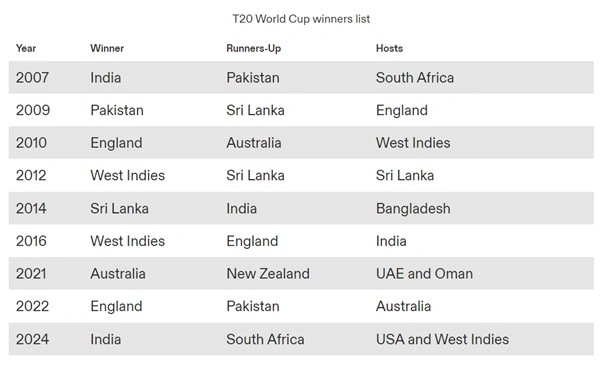 Individual Feats of T20 World Cup:
Individual Feats of T20 World Cup:
- Leading Run-Getter: Virat Kohli (IND) - 1292 runs in 35 matches since 2012.
- Top Wicket-Taker: Shakib Al Hasan (BAN) - 50 wickets in 43 matches between 2007 and 2024.
Key Highlights of the 2024 T20 Final:
- Player of the Match: Virat Kohli
- Player of the Tournament: Jasprit Bumrah
- Most Wickets in a T20 WC Edition:
- 17W - Arshdeep Singh (IND, 2024)
- 17 W - Fazalhaq Farooqi (AFG, 2024)
- Most Runs in 2024 T20 WC Edition:
- Rahmanullah Gurbaz (AFG. 281 Runs)
- Rohit Sharma (India 257 Runs)
- Lowest Economy Rate in a T20 WC Edition:17 - Jasprit Bumrah (2024)
- Defending Target: India became only the 3rd team to win the T20 WC final while defending the target after India in 2007 and West Indies in 2012.
- Unbeaten Record: India was unbeaten throughout the tournament, a first in T20 World Cup history.
- Retirements: Virat Kohli, Rohit Sharma, and Ravindra Jadeja announced their retirement from T20 internationals post the World Cup win.
- Prize Money: BCCI announced Rs 125 crore prize money for Team India after their T20 World Cup victory.
|
UPSC Civil Services Examination, Previous Year Question (PYQ) Prelims: Q:1 Consider the following statements in respect of the Laureus World Sports Award which was instituted in the year 2000: (2021)
Which of the above statements are correct? (a) 1 and 2 only (b) 2 and 3 only (c) 1 and 3 only (d) 1, 2 and 3 Ans: (c) |
Herpes
Why in the news?
- Recently, a study reveals that in 2016, high-income and upper-middle-income nations bore the highest economic burden from herpes infections.
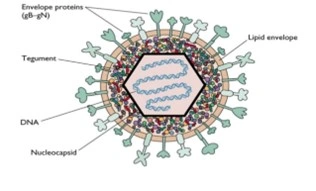
About Herpes Simplex:
- Herpes simplex is a viral infection caused by herpes simplex viruses (HSV).
- HSV resides within nerve cells, alternating between inactive and active phases.
- Transmission: Herpes spreads through direct contact with infected individuals or contaminated surfaces.
- Symptoms: Typically results in painful sores or blisters on the lips, mouth, genitals, and anus.
- Types:
- Type 1 (HSV-1):
- Mainly spread by oral contact.
- Causes oral herpes (cold sores) and can also lead to genital herpes.
- Most adults are infected with HSV-1.
- Type 2 (HSV-2):
- Spread through sexual contact.
- Causes genital herpes.
- Often asymptomatic or causes mild symptoms initially, with recurrent painful blisters or ulcers.
- Treatment: No permanent cure exists, but medications can suppress symptoms and reduce transmission.
- Prevention: Advocacy for safe sexual practices to prevent genital herpes (HSV-2) transmission. Education on the risks of oral-genital contact for HSV-1 transmission.
- Type 1 (HSV-1):
Prevalence:
- According to the 2016 data (last available estimates), 67% of the global population under 50 had HSV-1 infection (oral or genital). Most HSV-1 infections are acquired during childhood.
- HSV-2 type affects an estimated 13% of people aged 15–49 years worldwide.
- HSV-2 infects women almost twice as often as men since sexual transmission is more efficient from men to women.
In India:
- The National AIDS Control Organization (NACO) reports a prevalence of herpes ranging from 3% to 10%.
- Higher prevalence is noted in states like Karnataka, Maharashtra, and Gujarat.
Source: (DTE)
Nirman Portal
Why in the news ?
- Recently, the Union Minister for Coal and Mines recently launched the NIRMAN portal.

About NIRMAN Portal:
- Purpose:
- To assist talented youth from Coal India Limited's (CIL) operational districts who have qualified for the 2024 UPSC Civil Services and Forest Services Preliminary exams.
- Eligibility:
- Candidates eligible for financial assistance of Rs 1,00,000 must come from families with an annual income below Rs 8 lakhs.
- They should belong to Scheduled Castes, Scheduled Tribes, females, or the third gender, and must be permanent residents of any of CIL's 39 operational districts.
- Objective:
- The portal ensures transparency and efficient screening of applications, in line with the Digital India initiative envisioned by the Prime Minister.
Source: PIB
SCO Summit
Why in the news ?
- The 24th Meeting of the SCO Council of Heads of State (SCO Summit) will be held on 04 July 2024 in Astana, under the presidency of Kazakhstan.
- External Affairs Minister, Dr. S. Jaishankar will lead the Indian delegation to Astana for the Summit.
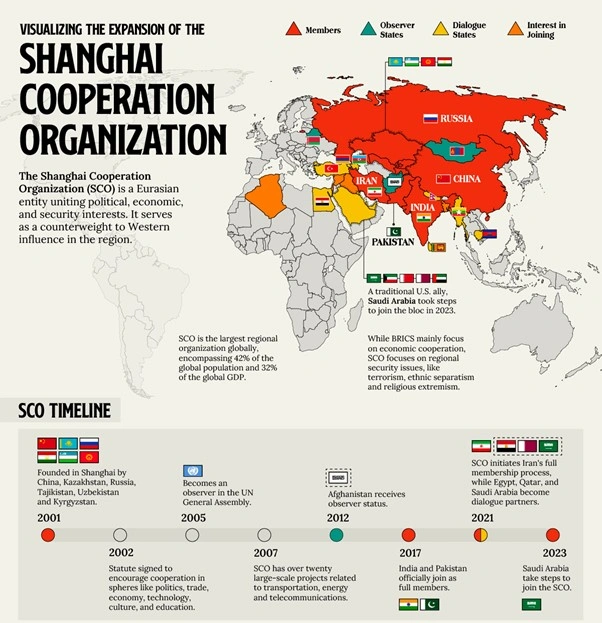
About Shanghai Cooperation Organization:
- About: Established in 2001, it is an intergovernmental alliance founded by Kazakhstan, China, Kyrgyzstan, Russia, Uzbekistan, and Tajikistan. The alliance focuses on political, economic, and security cooperation, with its first summit held in Shanghai, China.
- Aim: The SCO aims to enhance collaboration and solidarity across sectors including trade, investment, energy, transportation, and security.
- Objectives: The primary goals of the SCO are:
- Enhancing relations among member states.
- Fostering cooperation in political, economic, trade, scientific-technical, cultural, educational, energy, transportation, tourism, and environmental areas.
- Safeguarding regional peace, security, and stability.
- Promoting a democratic and equitable international political and economic order.
- Members: China, India, Kazakhstan, Kyrgyzstan, Russia, Pakistan, Tajikistan, Iran, and Uzbekistan.
- Observers: Observers consist of Afghanistan, Belarus, and Mongolia.
- Dialogue Partners: Armenia, Azerbaijan, Cambodia, Sri Lanka, Turkey, Egypt, Nepal, Qatar, and Saudi Arabia.
key points from PM Modi's remarks:
- On Rising Tensions:
- Emphasised the strain on international relations and global economic growth due to ongoing conflicts and rising tensions.
- Aimed at finding common ground to mitigate these consequences.
- On Terrorism:
- Highlighted the priority of combating terrorism, calling it a major threat to regional and global peace.
- Urged for decisive action against cross-border terrorism, terrorism financing, and radicalization of youth.
- On Climate Change:
- Addressed climate change as a significant concern, committing to emissions reduction, adoption of alternative fuels, electric vehicles, and climate-resilient infrastructure.
- On Connectivity:
- Stressed the importance of robust connectivity for economic development and cooperation, emphasising respect for sovereignty, territorial integrity, and non-discriminatory trade rights.
- On Technology:
- Acknowledged the centrality of technology in the 21st century, promoting its creative application for societal welfare and progress. Highlighted India's initiatives in AI cooperation within the SCO framework.
- On Central Asia:
- Recognized deep civilizational ties with Central Asia, prioritising their interests and aspirations through increased exchanges, projects, and cultural activities.
- On Cooperation:
- Described SCO cooperation as people-centric, citing India's initiatives like food festivals, film festivals, and cultural exchanges during its presidency.
- Emphasised unity and collaboration under the principle of Vasudhaiva Kutumbakam
|
UPSC Civil Services Examination, Previous Year Question (PYQ) Prelims Q:1 Consider the following: (2022)
India is a member of which of the above? (a) 1 and 2 only (b) 3 only (c) 2 and 3 only (d) 1, 2 and 3 Ans: (d)
Mains Q:1 Critically examine the aims and objectives of SCO. What importance does it hold for India? (2021) |
Source: LM
Digital Jurisprudence in India In an AI Era
Context:
- Generative AI (GAI) represents a transformative force with the potential to revolutionise various facets of society.
- While Generative AI is transformative and revolutionary, current legal frameworks and precedents designed for a pre-AI era may struggle to effectively govern its rapid evolution.
Key Contentious Issues Surrounding Internet Governance:
● Safe Harbour and Liability Fixation
- Issue: Determining the liability of intermediaries for the content they host.
- Key Judgement: The landmark Shreya Singhal judgement upheld Section 79 of the IT Act, granting intermediaries 'safe harbour' protection contingent upon meeting due diligence requirements.
- Challenge: The application of this protection to Generative AI tools remains problematic.
● The Copyright Conundrum
- Issue: The Indian Copyright Act of 1957 does not adequately address the complexities introduced by AI-generated works.
- Key Provision: Section 16 of the Act stipulates that no person is entitled to copyright protection except as provided by the Act.
- Critical Questions:
- Should existing copyright provisions be revised to accommodate AI?
- If AI-generated works gain protection, would co-authorship with a human be mandatory?
- Should recognition extend to the user, the program, and the programmer, or both?
- Parliamentary Standing Committee Report: The 161st report acknowledged that the Copyright Act is not well-equipped to facilitate authorship and ownership by AI.
- Current Law: A copyright owner can take legal action against infringers, with remedies such as injunctions and damages.
- Uncertainty: The question of who is responsible for copyright infringement by AI tools remains unclear.
- Terms of Use: ChatGPT's 'Terms of Use' attempt to shift liability to the user for illegal output, but the enforceability of such terms in India is uncertain.
● Privacy and Data Protection
- Key Judgement: The landmark K.S. Puttaswamy judgement (2017) by the Supreme Court of India established a strong foundation for privacy jurisprudence.
- Legislation: Digital Personal Data Protection Act, 2023 (DPDP).
- Privacy Concerns: While traditional data aggregators raise privacy concerns, Generative AI introduces a new layer of complexity.
- Rights: The DPDP Act introduces the "right to erasure" and the "right to be forgotten."
- Challenge:
- Once a GAI model is trained on a dataset, it cannot truly "unlearn" the information absorbed, raising critical questions about how individuals can exercise control over their personal information embedded in AI models.
Arguments Surrounding the Classification of GAI Tools:
● Arguments for GAI Tools as Intermediaries
- Function Similarity to Search Engines:
- GAI tools function similarly to search engines by responding to user queries without hosting external links or third-party websites.
- This operational similarity suggests they should be considered intermediaries eligible for safe harbour protection.
- Content Generation Based on User Prompts:
- GAI tools generate content based on user prompts, implying that the responsibility for the content lies primarily with the user, not the tool.
● Arguments Against GAI Tools as Intermediaries
- Active Content Creation:
- Critics argue that GAI tools actively create content, making them more than mere conduits.
- This active role in content creation should subject them to higher liability standards.
- Distinction Between User-Generated and Platform-Generated Content:
- The distinction between user-generated and platform-generated content becomes increasingly challenging.
- Unlike traditional intermediaries, GAI tools significantly transform user inputs into new outputs, complicating the liability landscape.
Judicial Precedents, Challenges, Real-World Implications and Legal Conflicts Surrounding the Classification of GAI:
● Judicial Precedent:
- The Delhi High Court's ruling in Christian Louboutin Sas vs. Nakul Bajaj and Ors (2018) introduced the concept of "passive" intermediaries, which applies to entities that merely transmit information without altering it.
- This ruling complicates the classification of GAI tools, as they do not fit neatly into the passive intermediary category due to their active role in content generation.
● Key Judicial Challenges:
- Distinguishing User-Generated Prompts vs. Platform-Generated Outputs:
- Courts must grapple with distinguishing between user-generated prompts and platform-generated outputs.
- This distinction is crucial for determining the extent of liability.
- Complexity in Liability Issues:
- Liability issues become more complex when AI-generated content is reposted on other platforms by users.
- Courts must decide whether the initial generation or subsequent dissemination attracts liability.
● Real-World Implications and Legal Conflicts:
- Generative AI has already led to legal conflicts in various jurisdictions. For instance, in June 2023, a radio host in the United States filed a lawsuit against OpenAI, alleging that ChatGPT had defamed him.
- Such cases highlight the ambiguity in classifying GAI tools and the resulting complications in assigning liability.
- Issues Raised:
- AI-generated content can lead to defamation or the spread of misinformation, raising questions about accountability.
- The debate continues over whether users should bear the primary responsibility for AI-generated content or whether the creators of GAI tools should be held liable.
Potential Solutions and Future Directions to Address the Challenges Posed by GAI:
● Learning by Doing: Temporary Immunity and Sandbox Approach
- Granting temporary immunity from liability to GAI platforms under a sandbox approach fosters innovation.
- It allows developers to experiment with new applications and enhance existing models without immediate legal concerns.
- Regulatory sandboxes provide a controlled environment for regulators to observe interactions between GAI tools and users, gathering valuable insights into legal, ethical, and practical challenges.
- Governments should establish these sandboxes, overseen by regulatory bodies or independent authorities, fostering a feedback loop among developers, regulators.
● Data Rights and Responsibilities: Overhauling Data Acquisition Processes
- Ensuring the legal acquisition of data used to train GAI models is essential for protecting intellectual property rights and maintaining public trust.
- Developers must acknowledge and compensate intellectual property owners whose data is used, ensuring a fair and transparent ecosystem.
- Governments should develop enforceable licensing agreements for data used in GAI training, outlining terms of use, compensation, and data owner rights.
● Licensing Challenges: Creating Centralised Platforms
- The decentralised nature of web data complicates licensing, hindering efficient access for developers.
- Centralised platforms can streamline this process, providing easier access to necessary data while maintaining its quality and integrity.
- Governments should establish centralised repositories or platforms akin to stock photo websites (e.g., Getty Images) for licensing web data.
- These platforms can offer standardised terms and facilitate access to diverse, accurate data for training GAI models.
Conclusion:
Hence, the evolving jurisprudence of Generative AI requires a comprehensive re-evaluation of digital laws. A holistic government approach and careful court interpretations are crucial to maximising benefits, safeguarding rights, and preventing harm. As GAI progresses, legal frameworks must adapt for responsible, ethical innovation that protects societal values.
|
UPSC Civil Services Examination, Previous Year Questions (PYQs) Mains: Q:1 What are the different elements of cyber security ? Keeping in view the challenges in cyber security, examine the extent to which India has successfully developed a comprehensive National Cyber Security Strategy.(UPSC 2022) Q:2 The emergence of the Fourth Industrial Revolution (Digital Revolution) has initiated e-Governance as an integral part of government”. Discuss. (2020) |
Source: TH
Share the article
Edukemy’s Current Affairs Quiz is published with multiple choice questions for UPSC exams
MCQ
Get Latest Updates on Offers, Event dates, and free Mentorship sessions.

Get in touch with our Expert Academic Counsellors 👋
FAQs
UPSC Daily Current Affairs focuses on learning current events on a daily basis. An aspirant needs to study regular and updated information about current events, news, and relevant topics that are important for UPSC aspirants. It covers national and international affairs, government policies, socio-economic issues, science and technology advancements, and more.
UPSC Daily Current Affairs provides aspirants with a concise and comprehensive overview of the latest happenings and developments across various fields. It helps aspirants stay updated with current affairs and provides them with valuable insights and analysis, which are essential for answering questions in the UPSC examinations. It enhances their knowledge, analytical skills, and ability to connect current affairs with the UPSC syllabus.
UPSC Daily Current Affairs covers a wide range of topics, including politics, economics, science and technology, environment, social issues, governance, international relations, and more. It offers news summaries, in-depth analyses, editorials, opinion pieces, and relevant study materials. It also provides practice questions and quizzes to help aspirants test their understanding of current affairs.
Edukemy's UPSC Daily Current Affairs can be accessed through:
- UPSC Daily Current Affairs can be accessed through Current Affairs tab at the top of the Main Page of Edukemy.
- Edukemy Mobile app: The Daily Current Affairs can also be access through Edukemy Mobile App.
- Social media: Follow Edukemy’s official social media accounts or pages that provide UPSC Daily Current Affairs updates, including Facebook, Twitter, or Telegram channels.

